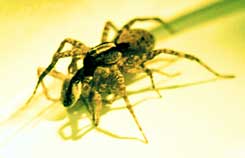These females fixate on males they saw in their youth

Freud would have been delighted: a story of sexual cannibalism originating from the experience of young females with older males. The sting is that it is spiders.
Eileen Hebets from Cornell University in New York State studies spiders from the wolf family. Like females of many other species of the arachnid series, the probability that the female wolf will devour a male in her path is roughly equal to the probability that she will mate with him. In fact, there are spider species where the female preys on the male immediately after mating, unless he is old enough to escape. But with wolves, the females announce their preferences long before mating, and they show great hostility towards any suitor who does not meet their requirements.
The Betts examined how the criteria for choosing a mate are formed in female spiders. She believed that they might be related to the appearance of the male, since appearance is an important criterion in many species. In male wolves there is great diversity in appearance, especially in the color of the front legs. Because the front legs participate in a complex display by which the spider signals that it is a potential mate, rather than a potential meal, Betts hypothesized that if there was any importance to the difference in appearance, it would be reflected in the color of the outstretched leg.
But she was not satisfied with that and also wondered if a preference for a black leg over a brown one - assuming it exists - is instilled in the female at an early stage of her life, before she has reached sexual maturity, under the influence of the males among whom she spent that period of time. To test the hypothesis, Betts pulled two shades of nail polish from her makeup bag and painted the legs of male spiders with them. She then exposed 81 young female spiders to a number of males whose legs were painted black, or to a number of males whose legs were painted brown. When the females arrived at the enclosure, they were placed in a box with a male, whose leg color matched or did not match the leg color of the males they were used to.
The findings, published in the journal "National Academy of Sciences" Proceedings of the were unequivocal. When the color of the legs of a male placed in a box with an adult female matched the color of the legs of the males she met in her youth, his chances of success and survival were high, although there were cases when the color matching did not save the male. Conversely, when the color of the male's legs did not match the color the female recognized, the result in almost all cases was that he became lunch.
Betts' experiment also had a control group. The researcher prevented a group of young females from having any contact with males. These females did not seem to notice the color of the suitors' legs at all. It turns out that in spiders, as in humans, the preferences in choosing partners are formed even before reaching sexual maturity.
